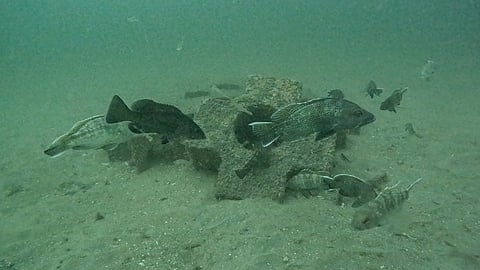New artificial reef study to support windfarm development off Virginia coast
Marine environmental consulting firm CSA Ocean Sciences has announced the preliminary findings of a year-long marine scientific study for the Bureau of Ocean Energy Management (BOEM) to evaluate the suitability of five Nature Inclusive Design (NID) materials for offshore wind cable or turbine foundation scour protection in Tower Reef, an artificial reef site managed by the Virginia Marine Resource Commission.
The study site is 0.6 nautical miles WSW of the Chesapeake Light Tower. In June 2023, following a thorough desktop study on both NID materials and the native and non-native species of the Mid-Atlantic region, CSA’s Ports and Coastal Infrastructure team carefully placed 15 artificial patch reefs (three of each design made from the five NID materials) within the sandy bottom survey site, located 12 nautical miles from Virginia Beach.
After three and 12 months, CSA and BOEM scientific divers conducted monitoring surveys to record the physical and ecological effectiveness of these scour protection materials as healthy hard bottom habitats for native reef (fish and invertebrate) communities and to evaluate the possibility of attracting invasive sea life.
Scientific divers were deployed to capture close-up, high-definition photographic images and perform a complete visual assessment of each artificial reef throughout the 12-month project cycle. These images were also used to generate accurate 3D and 2D-models—also known as photomosaics—to help calculate an accurate percent coverage of living epifaunal organisms on the reef units.
Additionally, CSA installed underwater time-lapse cameras to document and monitor the behaviour of fish and invertebrates around these artificial habitats. All five materials tested were found to be suitable substrates for NID applications. Among them, the A-Cube (pictured) demonstrated higher levels of both rugosity and the ability to support healthy epibiotic colonisation at the scale of this study.
This highly successful field campaign used novel subsea imaging techniques, including the utilisation of orthophotos to monitor the physical and biological conditions of the study materials to address fundamental questions with respect to invertebrate species colonisation and demersal fish use.
“BOEM's successful collaboration with CSA to assess the suitability of these NID materials comes at an important time for understanding the impacts of different materials that may be used in offshore wind energy projects in the United States," said Brandon Jensen, BOEM’s Contracting Officer Representative. “The results, which support the applicability of the NID materials investigated, point to a need to widen the scale of the study to further our understanding of how each type of scour material affects life for specific seabed structure/hardbottom species and ascertain whether those species attracted by the NID materials had a net positive or negative impact on the surrounding marine environment."


